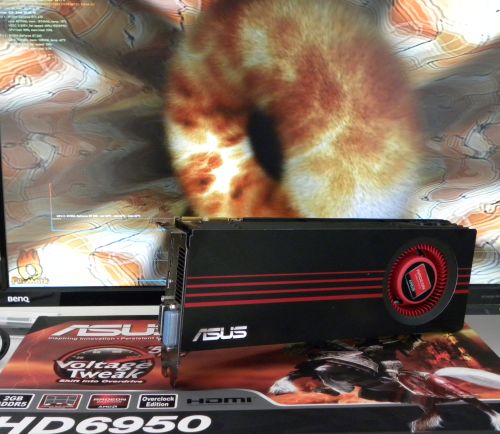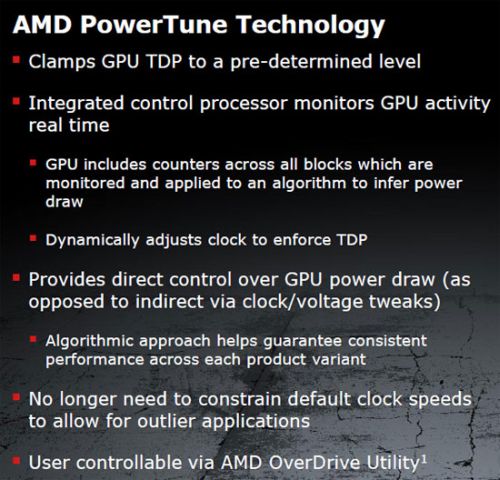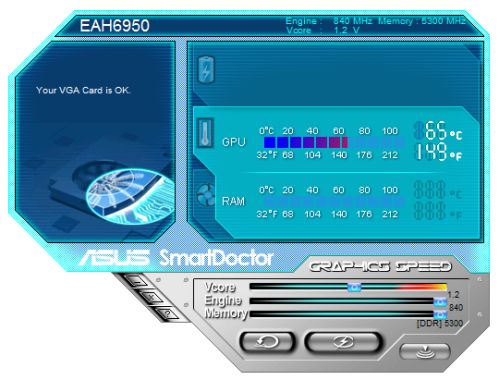ASUS Radeon HD 6950 Review Index
- 1 – Meet with ASUS’s Radeon HD 6950
- 2 – ASUS Radeon HD 6950 Features
- 3 – ASUS Radeon HD 6950 OpenGL performances
- 4 – ASUS Radeon HD 6950 Direct3D performances
- 5 – ASUS Radeon HD 6950 Gaming performances
- 6 – ASUS Radeon HD 6950 DirectCompute performances
- 7 – ASUS Radeon HD 6950 Power consumption and overclocking
7 – ASUS Radeon HD 6950 Power consumption and Overclocking

For the power consumption and overclocking test, I used the upcoming FurMark 1.9.0 (still not released due to a little lack of time but it should be there shortly!). The graphics workload in the new FurMark 1.9.0 has been slightly increased, leading to more power consumption (few watts in more). But this extra graphics workload can make the difference with high overclocking settings.
The total power consumption of my testbed in idle is 110W (HD 6950 with default clocks).
The Radeon HD 6950 integrates a new power draw limiter called PowerTune:

More information about PowerTune can be found in this post: AMD Radeon HD 6970 and HD 6950: Cayman GPUs are There!.
I tested the PowerTune technology here: [Tested] Radeon HD 6970 PowerTune Technology.
To overclock a Radeon HD 6950, you must set the PowerTune to +20% in Catalyst Control Center (CCC):
With default GPU clock speed (810MHz), the total power consumption of the testbed stressed by FurMark 1.9.0 is 329W for a max GPU temperature of 91°C (FurMark settings: 1920×1080, fullscreen, Burn-in mode, dynamic background, no AA, no postfx).
We can the calculate the power consumption of ASUS’s HD 6950. The Corsair AX1200 PSU has an efficiency factor of around 0.9 (see this article, there is a graph of the AX1200 efficiency).
P = (329-110) * 0.9
P = 197 watts
Under the same conditions, a Radeon HD 6970 shows a power consumption of: 260W for a GPU temperature of 93°C.
To overclock the ASUS HD 6950, I used ASUS SmartDoctor 5.74. SmartDoctor is ASUS’s overclocking utility:

Using SmartDoctor, and by modifying the GPU core clock only and GPU voltage, I managed to get a stable value under FurMark 1.9.0 for a GPU clock of 840MHz. Actually 840MHz is the max clock speed you can set in SmartDoctor and in other overclocking utilities.
To validate this GPU overclocking I ran FurMark 1.9.0 and 3DMark11 Extreme mode benchmarks.
Here are some tests I did:
- FurMark 1.9.0, GPU core: 810MHz, Vcore=1.100V. Total power consumption: 329W (HD6950 alone: 197W), GPU temp: 91°C (fan speed auto), FurMark 1.9.0 scorfe: 2047 points
- FurMark 1.9.0, GPU core: 840MHz, Vcore=1.200V. Total power consumption: 379W (HD6950 alone: 242W), GPU temp: 93°C (fan speed auto), FurMark 1.9.0 scorfe: 2099 points, 3DMark11 Extreme preset: X1638
- FurMark 1.9.0, GPU core: 840MHz, Vcore=1.300V. Total power consumption: 442W (HD6950 alone: 298W), GPU temp: 95°C (fan speed auto)
The last test with a GPU voltage of 1.3V was just for the fun. The HD 6950 is stable with a VDDC of 1.2V so no need to increase again the GPU voltage. With 1.3V, the EAH6950 alone reaches 300W…
And here are the scores to validate this overclocking:
GPU clock = 810MHz (default clock)
– FurMark 1.9.0: 2047 points (34 FPS)
– 3DMark11: X1594
GPU clock = 840MHz (max stable OC)
– FurMark 1.9.0: 2099 points (34 FPS)
– 3DMark11: X1638

To reproduce such overclocking test, I recommend you to have some quality hardware, because we exceed the electric specifications of the system. In my case, a GIGABYTE A-UD5 motherboard and a high-end PSU: Corsair’s AX1200!
Here is a comparative table of the power consumption of the card ALONE (not the total power consumption of the system):
| Power: 352W – EVGA GTX 580 SC (core: 880MHz, Vcore:1.082V) |
| Power: 330W – ASUS ENGTX580 (core: 871MHz, Vcore:1.088V) |
| Power: 324W – EVGA GTX 580 SC (core: 797MHz, Vcore:1.082V – default settings) |
| Power: 298W – ASUS Radeon HD 6950 (core: 840MHz, Vcore: 1.300V) |
| Power: 290W – ASUS ENGTX580 (default settings) |
| Power: 276W – SAPPHIRE Radeon HD 6970 (core: 940MHz, Vcore: 1.175V) |
| Power: 272W – EVGA GTX 480 |
| Power: 260W – SAPPHIRE Radeon HD 6970 (core: 880MHz, Vcore: 1.175V) |
| Power: 220W – SAPPHIRE Radeon HD 6870 (core: 1000MHz, Vcore: 1.300V) |
| Power: 197W – ASUS Radeon HD 6950 (core: 810MHz, Vcore: 1.100V) |
| Power: 185W – ATI Radeon HD 5870 |
| Power: 155W – SAPPHIRE Radeon HD 6870 (core: 900MHz, Vcore: 1.175V) |
| Power: 147W – ASUS EAH6870 |
| Power: 135W – MSI N460GTX Cyclone 768D5 OC |
ASUS Radeon HD 6950 Review Index
- 1 – Meet with ASUS’s Radeon HD 6950
- 2 – ASUS Radeon HD 6950 Features
- 3 – ASUS Radeon HD 6950 OpenGL performances
- 4 – ASUS Radeon HD 6950 Direct3D performances
- 5 – ASUS Radeon HD 6950 Gaming performances
- 6 – ASUS Radeon HD 6950 DirectCompute performances
- 7 – ASUS Radeon HD 6950 Power consumption and overclocking
Great stuff Jego! At last some gaming benchies! 😀
Some notes:
– The links at the first page do not work. Numbers 2 through 8 point to
http://www.geeks3d.com/20110117/tested-asus-radeon-hd-6950-2gb-gddr5-review/
– Is the 6950 Crysis score correct?
Personnal notes:
– Did AMD fix Hawx 2 at last? Cool! I haven’t done any testing on my 5850s recently.
– Now that the time finally came to play Crysis as it was supposed to be played, I gotten myself two new Geforces instead of two new Radeons, lol. No regrets though. The game runs fine. It’s actually cpu limited now. 😀
Oh…and what setttings were used in Crysis?
I wonder how much of AMD GPU’s lack of performance is due to the quality of their drivers.
@Psolord: thanks for the links bug. Fixed!
And yes the HD6950 score in Crysis is correct. I will bench again HD 6970 and HD 6950 when new drivers will be available because some scores (especially in OpenGL) are not coherent. For Crysis, I used the integrated GPU benchmark with default settings (I forgot the resolution sorry).
@Ash: I think too much.
Thanks for nice sharing JeGX.
Pingback: [Test] Hybrid Systems: Radeon HD 6950 for 3D and GeForce GT 240 for OpenCL - 3D Tech News, Pixel Hacking, Data Visualization and 3D Programming - Geeks3D.com
You can get the card to run at 950 MHz. I also had difficulty with Smart Doctor. Check my review at http://www.bjorn3d.com
You can get the card to run at 970 MHz. I also had difficulty with Smart Doctor. Check my review at http://www.bjorn3d.com
i have Asus 23″ VG236HE monitor connected with hdmi 20 pin cable to asus radion hd 6970 card,
i am running windows 7/64 but i cant run 3d nvidia ?
any help ?
I just bought the ASUS EAH6950 2GB video card running on a 24inch LED monitor but i find the graphics not being sharp. The edges around the fonts are abit fuzzy and videos are not sharp as well. Anyone know why this is so?
Oh yeah, found it so annoying how i had to play around with the scaling option to get full display on my monitor!
ASUS pre-sales claims the “power-up” wattage of the P8Q67M-DO MB is 330w. This is without a proc. or RAM. Can anyone with a three digit I.Q. tell me if this sounds even remotely possible ???